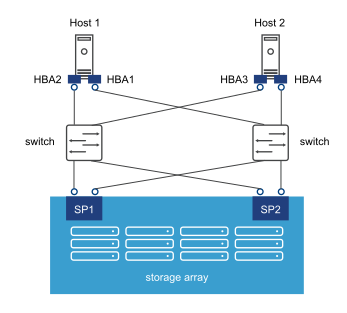Multipathing is a technique that lets you use more than one physical path that transfers data between the host and an external storage device.
In a simple multipathing local storage topology, you can use one ESXi host with two HBAs. The ESXi host connects to a dual-port local storage system through two cables. This configuration ensures fault tolerance if one of the connection elements between the ESXi host and the local storage system fails.
To support path switching with FC SAN, the ESXi host typically has two HBAs available from which the storage array can be reached through one or more switches. Alternatively, the setup can include one HBA and two storage processors so that the HBA can use a different path to reach the disk array.
In FC Multipathing, multiple paths connect each host with the storage device. For example, if HBA1 or the link between HBA1 and the switch fails, HBA2 takes over and provides the connection between the server and the switch. The process of one HBA taking over for another is called HBA failover.

If SP1 or the link between SP1 and the switch breaks, SP2 takes over and provides the connection between the switch and the storage device. This process is called SP failover. ESXi multipathing supports HBA and SP failover.
After you have set up your hardware to support multipathing, you can use the vSphere Client or ESXCLI commands to list and manage paths. You can perform the following tasks.
- List path information. See Listing Path Information with ESXCLI.
- Change path state. See Disable a Path with ESXCLI.
- Change path policies. See Set Policy Details for Devices that Use Round Robin.
- Mask paths. See the vSphere Storage documentation.
- Manipulate the rules that match paths to multipathing plugins to newly discovered devices. See Managing Claim Rules.
- Run or rerun claim rules or unclaim paths. See Managing Claim Rules.
- Rescan storage adapters. See Scanning Storage Adapters.